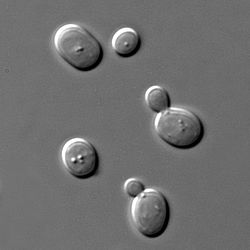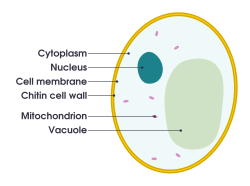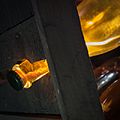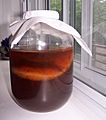Yeast facts for kids
Quick facts for kids Yeast |
|
|---|---|
 |
|
| Yeast cells under a microscope. | |
 |
|
| A diagram of a typical yeast cell | |
| Scientific classification | |
| Domain: | |
| Kingdom: | |
| Typical divisions | |
|
Ascomycota (sac fungi)
|
|
Yeast are tiny living things, so small you need a microscope to see them! They are a type of fungi, but unlike mushrooms, they are made of just one cell. There are around 1,500 different kinds, or species, of yeast. Most yeast make copies of themselves without needing a partner, which is called asexual reproduction. They often do this by "budding," where a small bump grows on the parent cell and then breaks off. Some yeast split into two equal parts, a process called binary fission.
One very famous type of yeast is called Saccharomyces cerevisiae. People have used this yeast for thousands of years! It's super important for baking bread and making many drinks. Yeast can also be used to create electricity and helps scientists learn about how cells work. While most yeast are helpful, a few types can cause infections in humans.
Contents
What is Yeast?
Yeast are tiny microorganisms that belong to the fungi kingdom. Unlike most fungi, which grow as many cells forming structures like mushrooms, yeast are usually made of just one cell. This makes them unique in the fungi family! They are found all over the world, living in soil, on plants, and even on our skin.
How Yeast Reproduces
Most yeast reproduce in a simple way called asexual reproduction. This means they don't need a partner to make new yeast cells.
Budding
The most common way yeast reproduce is by budding. Imagine a small bubble growing on the side of a yeast cell. This bubble gets bigger and bigger, and then it breaks off to become a brand new, separate yeast cell. It's like the parent cell is giving birth to a smaller version of itself!
Binary Fission
Some types of yeast reproduce using a method called binary fission. In this process, the yeast cell simply grows larger and then splits exactly in half, creating two identical new cells. It's a bit like dividing a cookie into two equal pieces.
Yeast in Our Lives
Yeast might be tiny, but they play a huge role in our daily lives, especially in food and drinks!
Baking Bread
One of the most amazing things yeast does is help us bake bread. When you mix yeast with flour, water, and a little sugar, the yeast eats the sugar. As it eats, it produces tiny bubbles of carbon dioxide gas. These gas bubbles get trapped in the dough, making it rise and become light and fluffy. Without yeast, bread would be flat and hard!
Making Drinks
Yeast is also essential for making many popular drinks through a process called fermentation.
Beer and Wine
In making beer and wine, yeast eats the sugars found in grains (for beer) or grapes (for wine). As the yeast consumes the sugar, it produces two main things: carbon dioxide (which creates bubbles) and ethanol, which is a type of alcohol. This is how alcoholic drinks get their kick!
Other Uses of Ethanol
The ethanol produced by yeast isn't just for drinks. It can also be used as a fuel for cars, especially in some countries. Scientists also use ethanol to make other important organic chemicals that are used in many products.
Yeast in Science and Health
Yeast is not just for food and drinks; it's also a superstar in the world of science.
Model Organism
Scientists often use yeast as a "model organism" to study how cells work. Because yeast cells are simple and grow quickly, researchers can easily experiment with them to understand basic life processes, like how cells grow, divide, and even get sick. What we learn from yeast can often help us understand human cells too!
Yeast and Health
While many yeasts are helpful, some types can cause infections in humans. These are called pathogens. For example, a common yeast called Candida albicans can sometimes cause thrush, which is a mild infection. But don't worry, most yeast are friendly and beneficial!
Images for kids
-
Yeast in a bottle during sparkling wine production at Schramsberg Vineyards, Napa
-
A kombucha culture fermenting in a jar
-
A photomicrograph of Candida albicans showing hyphal outgrowth and other morphological characteristics
See also
 In Spanish: Levadura para niños
In Spanish: Levadura para niños







